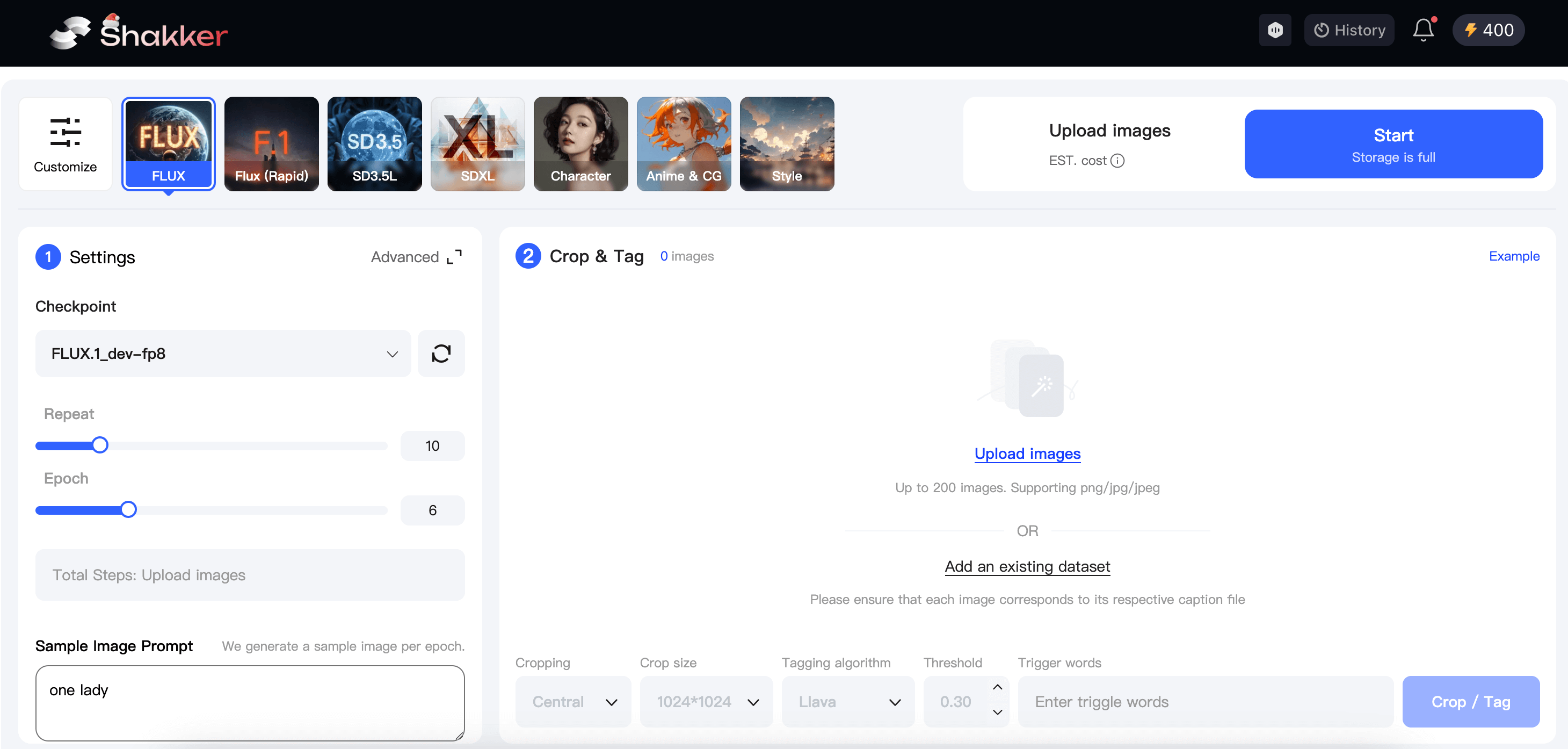¶ Explore LoRA AI: Lightweight Model Training for Creativity
In the ever-evolving world of artificial intelligence, LoRA AI (Low-Rank Adaptation) is redefining how large models are trained, making it more efficient, cost-effective, and accessible for users across various domains. LoRA stands out as a game-changing approach to training large-scale models with significantly fewer resources while maintaining exceptional performance.

One of the biggest hurdles in model training has traditionally been the time, computational power, and memory required. LoRA addresses these challenges with its innovative method of reducing trainable parameters. This approach enables faster training, lower memory consumption, and lightweight model sharing.
Shakker AI’s LoRA Training Tool
How to Use Shakker AI for LoRA AI Training
At the forefront of this technological revolution is Shakker AI, a robust platform that integrates LoRA seamlessly into its suite of tools. By offering features like custom image generation, inpainting, and advanced model settings, Shakker AI leverages LoRA to empower creators, developers, and businesses alike. Whether you're experimenting with LoRA AI image generators or diving into model customization with tools like A1111 WebUI and ComfyUI, Shakker AI provides a streamlined experience tailored to your needs.
¶ What is LoRA AI?
LoRA (Low-Rank Adaptation) is a breakthrough in machine learning that optimizes how large language and image models are fine-tuned for specific tasks. Instead of retraining an entire model, LoRA adds a small number of new trainable weights into the existing model while freezing the rest. This method drastically reduces the number of parameters being trained, improving efficiency and memory usage without compromising quality.
Imagine you’re training an AI model for a specific style of art, such as anime or photography. With traditional methods, you might need to fine-tune hundreds of millions of parameters. In contrast, LoRA allows you to adjust only a fraction of those parameters, resulting in smaller, more portable model weights (often just a few hundred megabytes).
LoRA’s applications are vast. It is commonly used in:
- Text-to-image generation: Tools like Stable Diffusion leverage LoRA to create stunning visuals.
- DreamBooth: Enhance and personalize models for specific subjects or themes.
- Kandinsky 2.2: A text-to-image generator known for its creative versatility.
- Civitai LoRA models: A popular community resource for pre-trained LoRA models in different artistic styles.
By making model adaptation more lightweight and efficient, LoRA has become a cornerstone in the field of AI.
¶ The Advantages of LoRA AI
LoRA’s popularity is no accident—it offers several distinct advantages that make it ideal for both professional and creative use cases:
¶ 1. Faster and Memory-Efficient Training
LoRA requires significantly fewer resources for training. By reducing the number of trainable parameters, it speeds up the process and lowers hardware demands.
¶ 2. Smaller Model Weights
Models trained with LoRA produce smaller weights, making them easier to share, deploy, and store. This is especially beneficial for creators working on resource-limited devices or cloud platforms.
¶ 3. No Additional Inference Latency
Unlike other training methods, LoRA doesn’t increase inference latency. This makes it suitable for real-time applications, such as live AI art generation or on-the-fly image processing.
¶ 4. Versatility Across Technologies
LoRA integrates seamlessly with cutting-edge AI technologies like DreamBooth, Civitai LoRA, Shakker AI LoRA, and Kandinsky 2.2, offering users diverse applications ranging from creative projects to large-scale deployments.
¶ 5. Broad Compatibility
LoRA works across multiple model types, including Stable Diffusion XL, text-to-image pipelines, and even Llama 3 AI, a large language model renowned for its adaptability and performance.
¶ Shakker AI’s LoRA Training Tool
Shakker AI is a comprehensive platform that integrates the power of LoRA into its ecosystem, providing users with unmatched flexibility and creativity.

Here’s what sets it apart:
¶ 1. Custom Mode
Shakker AI’s Custom Mode offers an intuitive interface for:
- Prompt-Based Image Generation: Easily create images with detailed prompts.
- Img2Img Transformations: Transform existing images into unique artworks.
- Advanced Settings: Customize model parameters, samplers, and adetailer for enhanced outputs.
¶ 2. Canvas Tools
Shakker AI’s Canvas Mode includes tools for seamless image editing:
- Inpaint & Outpaint: Fill missing parts of an image or extend its background creatively.
- Upscale: Enhance image resolution without losing quality.
- Remove Background: An AI-powered feature for precise and efficient background removal.
- Collage and Crop: Tailor your visuals for creative projects or professional use.
¶ 3. A1111 WebUI and ComfyUI Integration
Shakker AI integrates these tools for streamlined workflows in diffusion-based image generation, making it ideal for users experimenting with LoRA AI image generators.
¶ 4. Active Model Community
Shakker AI connects users to a vibrant model community, including SD, Flux, and NoobAI models. These models span various styles such as anime, photography, and illustration, catering to diverse creative needs.
¶ 5. Lightweight LoRA Models
For users exploring the capabilities of Llama 3 AI or pre-trained Civitai LoRA models, Shakker AI provides a seamless environment to train, deploy, and experiment with lightweight models.
¶ How to Use Shakker AI for LoRA AI Training
Using Shakker AI’s LoRA training tool is simple and intuitive. Here’s a step-by-step guide:
- Access the Platform
Sign up or log in to the Shakker AI platform. Navigate to the LoRA training tool within the dashboard.
- Import or Select a Model
Choose from existing models like SDXL or import pre-trained models from platforms like Civitai LoRA.
- Customize Model Parameters
Adjust settings such as prompt inputs, model configurations, and img2img options to fine-tune your results.
- Apply LoRA-Specific Adjustments
Enable LoRA to train lightweight, task-specific model weights without retraining the entire model.
- Export and Share
Save your trained models as lightweight LoRA files, making them easy to share and deploy across projects.
By integrating these steps into your workflow, you can leverage the full power of LoRA for efficient and creative AI tasks.
¶ Final Words
In the dynamic landscape of AI, LoRA AI has emerged as a revolutionary technique for lightweight and efficient model training. By reducing resource demands while maintaining top-tier performance, it has become an essential tool for creators and developers alike.
Platforms like Shakker AI take this innovation further by providing powerful tools for custom image generation, seamless editing, and LoRA integration. Whether you’re exploring LoRA AI image generators, fine-tuning models with Civitai LoRA, or diving into advanced tools like Llama 3 AI, Shakker AI empowers you to achieve your creative and professional goals effortlessly.
Try Shakker AI today and experience the future of AI-driven creativity firsthand.
¶ Related Posts:
- Dreambooth Stable Diffusion Tutorial for Beginners >>
- SDXL Turbo AI: Shakker AI's Powerful Online Image Generation Tool >>
- LoRA X: Revolutionizing AI Model Serving with Shakker AI >>
- Comprehensive Tutorial to LoRA Training & Tools >>
- Textual Inversion: Unlocking Stable Diffusion’s Full Potential >>